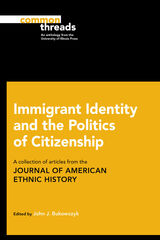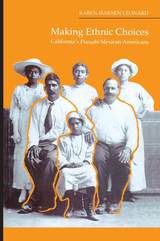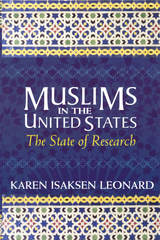3 books by Leonard, Karen

Immigrant Identity and the Politics of Citizenship
A Collection of Articles from the Journal of American Ethnic History
John J Bukowczyk
University of Illinois Press, 2016
The next volume in the Common Threads book series, Immigrant Identity and the Politics of Citizenship assembles fourteen articles from the Journal of American Ethnic History . The chapters discuss the divisions and hierarchies confronted by immigrants to the United States, and how these immigrants shape, and are shaped by, the social and cultural worlds they enter. Drawing on scholarship of ethnic groups from around the globe, the articles illuminate the often fraught journey many migrants undertake from mistrusted Other to sometimes welcomed citizen. Contributors: James R. Barrett, Douglas C. Baynton, Vibha Bhalla, Julio Capó, Jr., Robert Fleegler, Gunlög Fur, Hidetaka Hirota, Karen Leonard, Willow Lung-Amam, Raymond A. Mohl, Mark Overmyer-Velázquez, Lara Putnam, David Reimers, David Roediger, and Allison Varzally.
[more]

Making Ethnic Choices
California's Punjabi Mexican Americans
Karen Isaksen Leonard
Temple University Press, 1994
"[A] thoroughly original study that greatly expands our knowledge of how ethnic identities are formed. Leonard writes clearly and her inclusion of the voices of the Punjabi-Mexicans lends humor and depth to the history. This insightful study will be of interest to all scholars concerned with immigration and ethnicity and the history of California."
--The Journal of Asian Studies
This is a study of the flexibility of ethnic identity. In the early twentieth century, men from India's Punjab province came to California to work on the land. The new immigrants had few chances to marry. There were very few marriageable Indian women, and miscegenation laws and racial prejudice limited their ability to find white Americans. Discovering an unexpected compatibility, Punjabis married women of Mexican descent and these alliances inspired others as the men introduced their bachelor friends to the sisters and friends of their wives. These biethnic families developed an identity as "Hindus" but also as Americans. Karen Leonard has related theories linking state policies and ethnicity to those applied at the level of marriage and family life. Using written sources and numerous interviews, she invokes gender, generation, class, religion, language, and the dramatic political changes of the 1940s in South Asia and the United States to show how individual and group perceptions of ethnic identity have changed among Punjabi Mexican Americans in rural California.
"This is an extraordinary work. It is simultaneously an ethnography of early South Asian immigrant life in California, a model of fine-grained historical research using all manner of documents to reconstruct and interpret the migration flows, social structure, and family cycles of Punjabi men and their Mexican spouses, and a sophisticated examination of the complex role of 'identity' in their perceptions of themselves and their descendants.... In the midst of contemporary discussions about multi-culturalism, politically correctly positions, and valuing diversity, this book would be a fine place to begin a thoughtful consideration of the potential multiplicity of meanings ethnicity may have for human begins."
--Journal of American Ethnic History
"No other book has the scope or the vision of Karen Leonard's work. I expect this book to be consulted as a model of historical research for many years to come."
--James Freeman, San Jose State University
[more]

Muslims in the United States
The State of Research
Karen Isaksen Leonard
Russell Sage Foundation, 2003
As the United States wages war on terrorism, the country's attention is riveted on the Muslim world as never before. While many cursory press accounts dealing with Muslims in the United States have been published since 9/11, few people are aware of the wealth of scholarly research already available on the American Islamic population. In Muslims in the United States: The State of Research, Karen Isaksen Leonard mines this rich vein of research to provide a fascinating overview of the history and contemporary situation of American Muslim communities. Leonard describes how Islam, never a monolithic religion, has inevitably been shaped by its experience on American soil. American Muslims are a religious minority, and arbiters of Islamic cultural values and jurisprudence must operate within the framework of America's secular social and legal codes, while coping with the ethnic differences among Muslim groups that have long divided their communities. Arab Muslims tend to dominate mosque functions and teaching Arabic and the Qur'an, whereas South Asian Muslims have often focused on the regional and national mobilization of Muslims around religious and political issues. By the end of the 20th century, however, many Muslim immigrants had become American citizens, prompting greater interchange among these groups and bridging some cultural differences. African American Muslims remain the most isolated group—a minority within a minority. Many African American men have converted to Islam while in prison, leading to a special concern among African American Muslims for civil and religious rights within the prison system. Leonard highlights the need to expand our knowledge of African American Muslim movements, which are often not regarded as legitimate by immigrant Muslims. Leonard explores the construction of contemporary American Muslim identities, examining such factors as gender, sexuality, race, class, and generational differences within the many smaller national origin and sectarian Muslim communities, including secular Muslims, Sufis, and fundamentalists. Muslims in the United States provides a thorough account of the impact of September 11th on the Muslim community. Before the terrorist attacks, Muslim leaders had been mostly optimistic, envisioning a growing role for Muslims in U.S. society. Afterward, despite a brave show of unity and support for the nation, Muslim organizations became more open in showing their own conflicts and divisions and more vocal in opposing militant Islamic ideologies. By providing a concise summary of significant historical and contemporary research on Muslims in the United States, this volume will become an essential resource for both the scholar and the general reader interested in understanding the diverse communities that constitute Muslim America.
[more]
READERS
Browse our collection.
PUBLISHERS
See BiblioVault's publisher services.
STUDENT SERVICES
Files for college accessibility offices.
UChicago Accessibility Resources
home | accessibility | search | about | contact us
BiblioVault ® 2001 - 2024
The University of Chicago Press









